Adria’s Euro design channels IKEA but will it pack flat in Aussie conditions?
Words & images Anthony Kilner
Adria caravans are manufactured in Slovenija (or, as it’s often written, Slovenia. They have been imported by Apollo RV in Queensland since 2013 to complement its caravan and motorhome product range in Australia. Adria is reportedly one of the top three European manufacturers of caravans and motorhomes, and has been building vans since 1965.
There is a strong relationship between Adria and Apollo with the two companies constantly sharing information and working to build vans that will handle our Aussie conditions, tow well and offer value for money.
The biggest advantage to the Altea 552 PK Sport is the weight factor. With an ATM of just 1800kg and a tare weight of 1460kg, it can be towed legally by a range of mid-sized vehicles. This could be the perfect answer for people wanting to get into vanning affordably as not having to buy a new tow vehicle saves thousands of bucks.
The tow vehicle might need a little work to get it ready for legal towing with a towbar, maybe some suspension work, tow mirrors and the like; however, that’s a small cost compared to buying a bigger tow-ready vehicle. Adria has recognised a market for couples, families or grandparents who tour and need beds for the grand-kiddies when they visit – with a package that provides a full ensuite and enough room to move.
With the ‘why’ covered, lets take a deeper look at the ‘what’ – what is the Altea 552 PK Sport?
Outside
The mechanicals of the Altea are one big list of AL-KO components, starting with a hot-dipped gal chassis and independent rubber suspension system including shockers with a 1800kg-rated single axle. Braking is handled via an overrun system. Add to that the AL-KO anti-sway coupling and tow ball locking plate, reinforced wind-down stabilising legs and an eight-inch jockey wheel that locks into place on the A-frame.
The idea behind that is the jockey wheel sits just below the level of the A-frame and if the van un-couples for any reason, it drops onto the wheel rather than onto the road. Only one safety chain is used to secure the van to the vehicle (because, being under two tonnes, two chains aren’t required).
The Sport version has upgraded 16-inch steel rims rather than the standard 14-inch alloy rims. I asked why they didn’t fit alloy rims as part of the upgrade. It seems that they reckon the steel wheel option offers more durability for our Aussie conditions; which is a fair argument.
The spare tyre is located in the front boot for easy access, which also means it’s clean if you have to change a tyre on the road. Other features include a 130-litre water tank, Thule awning, drop step, and a 100Ah battery with fused electrical system.
Around the body are protective little hatches to cover the water tank filler and gas bayonet; and even external power for TV and USB sockets. Up on the roof is a good-size hatch and a Winegard Sensar antenna for the telly (which mounts on the driver’s side of the van in the bedroom).
The body, which is referred to as ‘the modern look’ by Adria, is made up of sandwich panels on the sidewalls and roof while the front and back walls are impact-resistant ABS panels. Even the floor has its own sandwich panel construction with kiln-dried plywood and insulation.
The Sport also features ABS body trim. Add double-glazed windows and some chequer plate and the overall look is certainly modern… although there will be happy-hour debate over how good this van looks between folks who will like it and those folk who won’t.
The front boot also houses twin 4.5kg gas bottles that can be upgraded to twin 9kg bottles if required. While mentioning options, solar panels, a rear camera and a drop-down table are others items available with this van. On the driver’s side there’s a storage boot that can also be accessed from under the main bed across the front of the wall. This is a great space for long storage. It also houses the battery and electrical system.
One of the key features (pardon the pun) is that there’s only one key needed to open everything on the van. According to Adria, this is a key selling point.
Inside
Entry is via a drop step towards the front of the van. This unit features a two-piece barn-style door. While it could be practical, it can’t be used with the fly screen in place because the handle hits the screen. I love the idea – but in our Aussie conditions with flies and mozzies (and the need for plenty of ventilation) it’s not totally practical.
A French-style bed runs across the front of the van in east-west configuration. While this is practical for the layout of the van, I am not enamoured with climbing over people to get in and out of bed (although I know it works for some). There is storage above the bed and access to the under-bed boot space as mentioned.
The café dinette is amidships on the passenger side and it doubles as a bed if required. This seating is suitable for four (two kids and two adults, just) and is comfortable enough with good head space. There’s practical storage in overhead cupboards and under the seats.
Keeping to the driver’s side, next to the dinette and running to the back wall are the bunk beds. These are reasonably sized and comfortable. Each bunk has its own light and window; and due to the shape of the roof the top bunk has a little more headroom for taller kids. Under the bottom bunk is a Truma Saphir Comfort RC split system that feeds into the van via multiple ducts. This means that the travel height remains lower, as no roof-mounted AC is needed.
Opposite the bunks is a full ensuite. On the back wall there’s a great cupboard/wardrobe for clothing and other items.
I liked the ensuite as a space. The room is closed off with a main door. Inside, the shower is located on the back wall and it’s big enough for larger blokes like me. Opposite the shower is the toilet unit complete with a pull-out basin and great vanity mirror that opens up allowing easy access to the storage within, and a power point for the hair dryer or shaver.
Between the ensuite and the access door is the kitchen. This space is not huge; but when you consider how much is squeezed into a 20-foot body it’s pretty good. It includes a three-burner gas cooktop that drains into the sink, which is awesome if you are like me and tend to boil things over regularly when cooking.
Under the bench is a Thetford oven/grill unit and around it there’s plenty of cupboard space. For alternative cooking options a Camec microwave unit is located above a large 190-litre Dometic fridge freezer. The kitchen is well laid out and practical. When you step back and look at the overall design, it works well for the size.
Verdict
Personally, I always wonder whether lightweight imported vans will hang together on our Aussie roads. As this is a first review, all we can do is check it out and offer an opinion on the looks and build… and whether there is anything that jumps out as a potential problem.
I liked the list of features and the weight, which will allow a lot of vehicles to tow this van and help families and others to get into touring economically. Hopefully it will keep them happy for many years to come.
While I didn’t tow this van a huge distance, I did cover a fair range of road surfaces in varying terrain. I was impressed by how well it towed and sat on the road.
Specifications
Body length: 6.31m (20ft, 8in)
Body width: 2.36m (7ft, 9in)
Tare weight: 1460kg
ATM: 1800kg
Price as tested: $43,547 drive-away ex Melbourne
Cons
- Angled bed across the front of the van (access)
- The two-piece door is not functional with the fly screen
- Electrical system: You can’t use the lights in the van if it’s connected to the car… this is to stop the battery draining, according to Adria.
Pros
- Overall weight
- No need to buy a new tow vehicle in some cases
- A quirky stove that drains into the sink
- Five-berth
- Price point
- One-key functionality






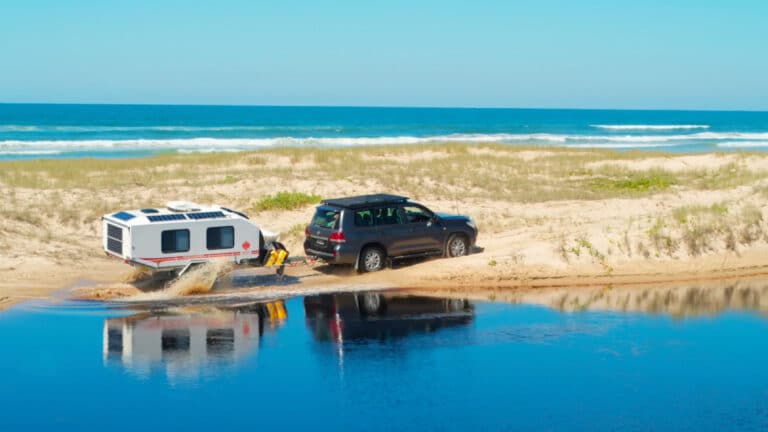
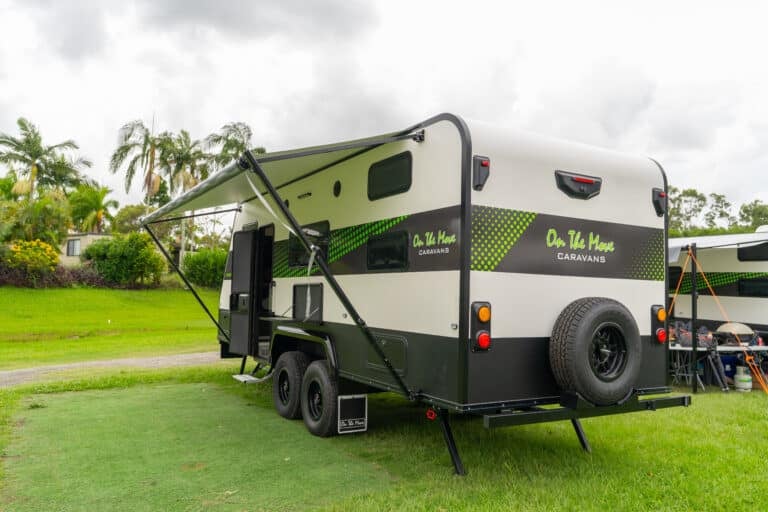
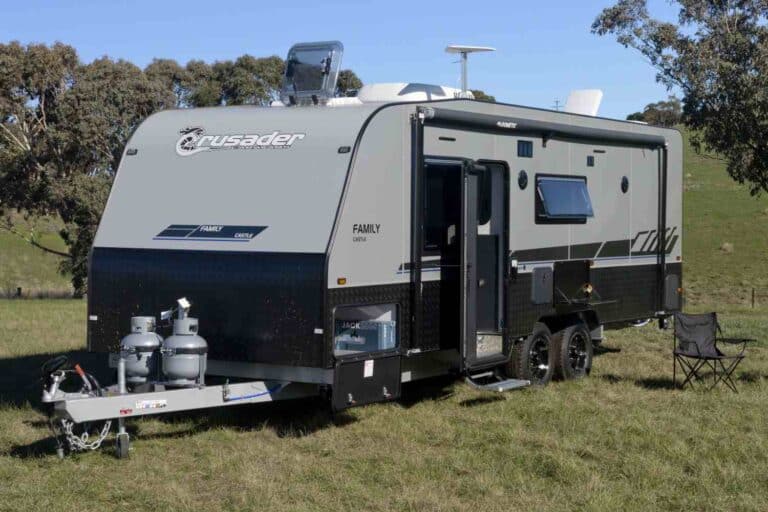

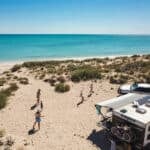
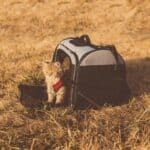
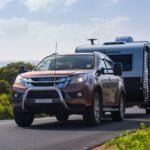
How much?
How much?